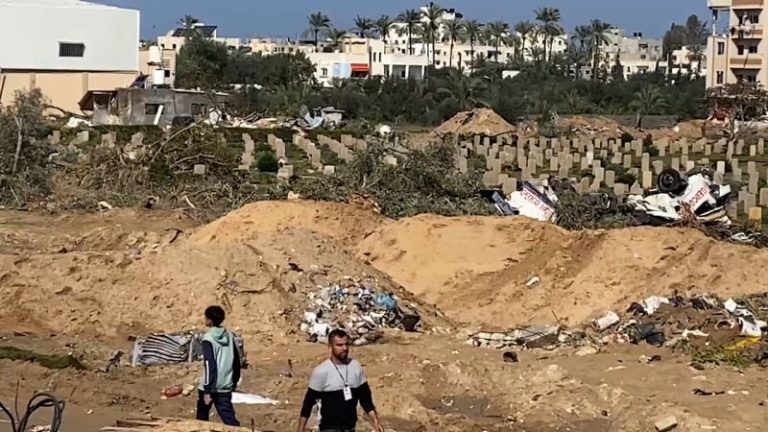The IDF said rescuing the hostages and finding and returning their bodies is one of its key missions in Gaza, which is why bodies were removed from some gravesites.
In the Shajaiya neighborhood of Gaza City, Israeli military vehicles could be seen where the cemetery once stood, with berms surrounding them on all sides. The central part of the Shajaiya cemetery was cleared before the war, according to local media reports. But satellite imagery showed other portions were more recently bulldozed, and an IDF presence visible, from December 10.
A similar scene of destruction was visible at the Bani Suheila cemetery, east of Khan Younis, where satellite imagery revealed the graveyard’s deliberate and progressive bulldozing, and the creation of defensive fortifications over the course of at least two weeks in late December and early January.
At the Al Falouja cemetery in the Jabalya neighborhood, north of Gaza City, the Al-Tuffah cemetery, east of Gaza City, and a cemetery in Gaza City’s Sheikh Ijlin neighborhood, destroyed tombstones and heavy tread marks pointed to heavily armored vehicles or tanks driving over graves.
Israel has said that 253 people were taken hostage during the Hamas terror attacks on October 7 and believes 132 hostages are still in Gaza – 105 of them alive and 27 dead.
‘I couldn’t find her grave’
Munther al Hayek’s daughter Dina was killed in the 2014 Gaza war. In early January he visited Dina’s grave at Sheikh Radwan cemetery in Gaza City, but she wasn’t there. He tried to find his grandmother’s grave. It wasn’t there either.
Mosab Abu Toha, a poet from Gaza whose work has been published in the New York Times and the New Yorker, also learned that the cemetery where his younger brother and grandfather are buried was heavily damaged by the Israeli military.
The occupation forces destroyed and bulldozed them… The scenes are horrific. We want the world to intervene to protect Palestinian civilians.”
Munther al Hayek, whose daughter’s grave was destroyed
The death toll in Gaza is growing by the day. More than 24,000 Palestinians have been killed in Israeli attacks, according to the Hamas-controlled Ministry of Health in Gaza. Burials often happen quickly in accordance with Islamic practice, and, since the war began, the dead have often been buried in mass graves.
Respecting the dead
International law experts say the desecration of burial grounds contravenes the Rome Statute, the 1998 treaty that established and governs the International Criminal Court (ICC) to adjudicate war crimes, genocide, crimes against humanity, and crimes of aggression. Israel, which originally supported the creation of the court, did not ratify the Rome Statute.
Cemeteries are given protections as “civilian objects” under international law and are afforded special protections, with limited exceptions.
Cemeteries can only be attacked or destroyed if the other warring party uses them for military purposes, or if doing so is deemed a military necessity, with the military advantage gained outweighing the damage to civilian objects.
South Africa raised the IDF’s destruction of graveyards in Gaza as part of its case at the International Court of Justice arguing Israel is committing genocide. Israel denies the allegation, but Dill said that while the destruction of cemeteries alone does not amount to genocide, it can add to evidence of Israel’s intent.
“There’s huge symbolic meaning to the notion that not even the dead are left in peace,” Dill said. “International humanitarian law protects the dignity of people who are outside of combat or the combat, and that protection doesn’t end when they die.”
But, in at least two cases, it is clear pains have been taken to respect the dead – at cemeteries where Palestinians aren’t buried.
Just a half mile away from the destroyed Al-Tuffah cemetery, east of Gaza City, a cemetery holding the bodies of mostly British and Australian soldiers who died in World War I and II stands largely intact. A crater on the burial grounds appears in satellite imagery between October 8 and October 15, but it has otherwise been untouched by the war.
A second cemetery administered by the Commonwealth War Graves Commission in central Gaza offers an even starker example. Mangled vehicles and destroyed roads lay all around the cemetery. But the graveyard itself, which contains the graves of mostly Christians and some Jewish soldiers from World War I, is intact.
What is happening is a clear violation of these basic rules and considered a war crime of ‘committing outrages upon personal dignity’ under the Rome Statute.”
Muna Haddad, a human rights lawyer
Israeli soldiers even posed with an Israeli flag by the grave of a Jewish soldier buried there and another image posted to social media shows a tank sitting on the edge of the graveyard – respecting the sanctity of that hallowed ground.
“What is happening is a clear violation of these basic rules and considered a war crime of ‘committing outrages upon personal dignity’ under the Rome Statute,” she said.

